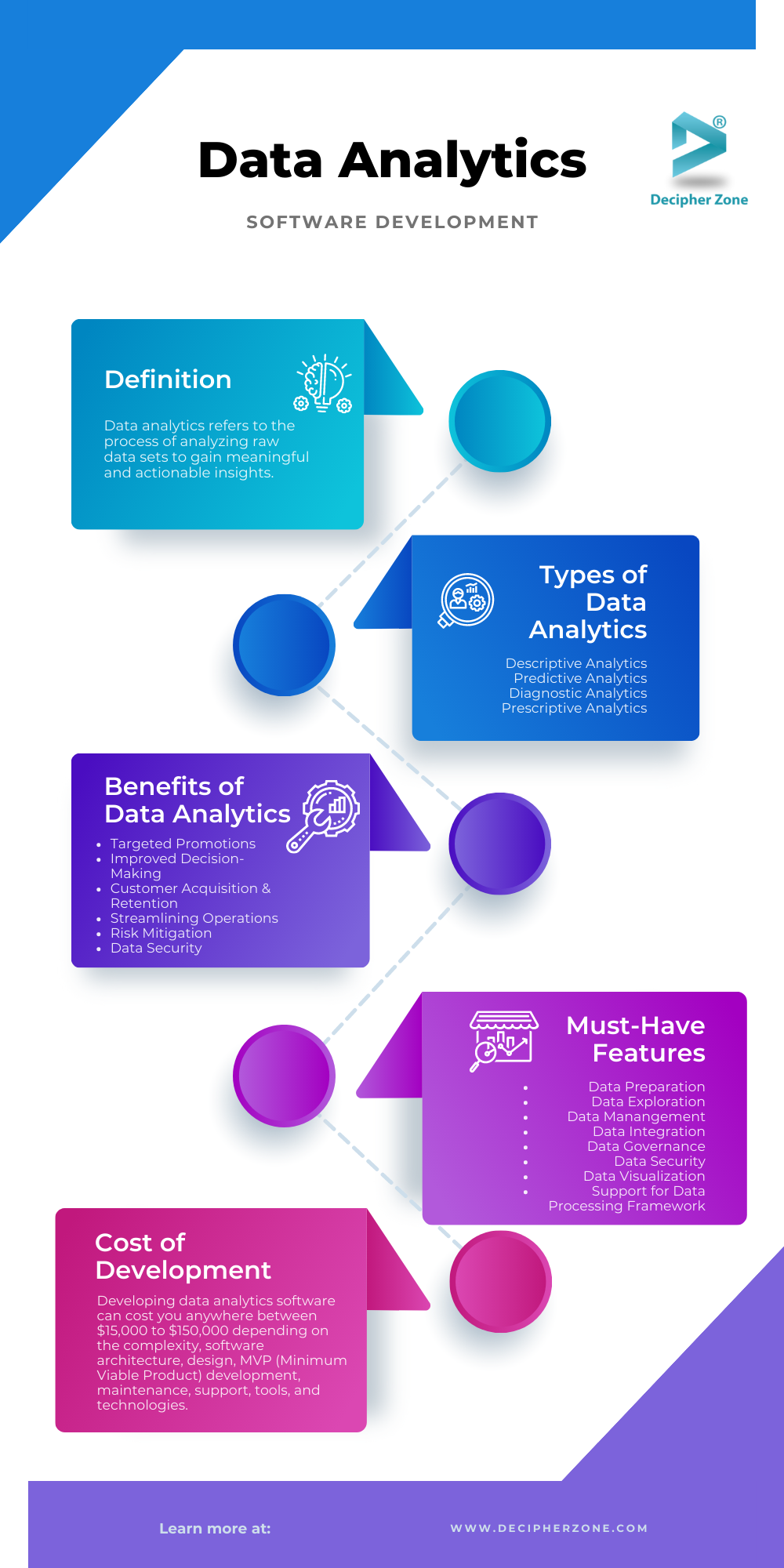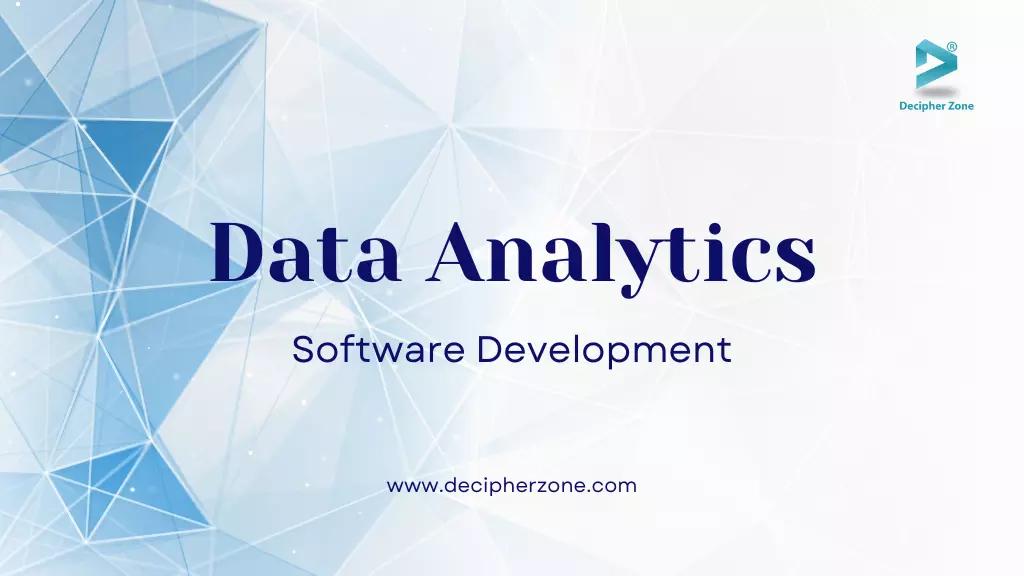Based on the latest insights, 328.77 million terabytes of data are generated daily. And organizations across industries need this data for valuable insights to enhance their decision-making capabilities.
Due to this, collecting, tracking, storing, and analyzing data using data analytics tools and software development has become increasingly popular.
Data Analytics Software Development: Types, Benefits, Features and Cost
While you might have heard about data analytics, it is highly possible that you don’t know what it means. So, in this article, we will dive into the world of data analytics software and how it can help your business achieve its goals.
What is Data Analytics?
Data analytics refers to the process of analyzing raw data sets to gain meaningful and actionable insights. It can analyze historical as well as real-time, structured, and unstructured data to identify patterns, provide insights, and automates decisions (sometimes).
With data analytics software, businesses can easily transform their operational methods, performances, and work culture. As a digital strategy catalyst, data analytics allows businesses to make accurate decisions at the right time and help them transform themselves at a rapid pace.
Types of Data Analytics
Data analytics can be categorized into four types.
-
Descriptive Analytics
-
Predictive Analytics
-
Diagnostic Analytics
-
Prescriptive Analytics
But what does each of them refer to? Let’s find out.
1. Descriptive Analytics
It refers to the analysis of historical and current data or information to identify what had happened in the business over a period of time. Descriptive analytics is often characterized by visualizations (like bar charts, pie charts, tables, line graphs, etc.) and traditional business intelligence (BI).
2. Predictive Analytics
In predictive analytics, historical data is analyzed for identifying trends and patterns to predict future events and trends using machine learning techniques and statistical algorithms.
3. Diagnostic Analytics
It is advanced data analytics used to analyze data or information to identify why something has happened. Diagnostic analytics is often characterized by data mining, data discovery, drill-down analysis, and data correlation. It involves a bit of hypothesizing and diverse data input.
Read: Virtual Hospital Software Development
4. Prescriptive Analytics
It refers to the data analysis done to recommend ways to leverage future opportunities or downplay future risks. Prescriptive analytics also show the logical consequences of each decision to optimize business decisions and practices.
Benefits of Developing a Data Analytics Software
Here we have listed some of the advantages that data analytics software offer to a business:
-
Targeted Promotions
-
Improved Decision-Making
-
Customer Acquisition and Retention
-
Streamlining Operations
-
Mitigating Risks
-
Better Data Security
Multiple benefits of data analytics can be acquired by businesses across industries.
1. Targeted Promotions
Data analytics software analyzes customer trends to help organizations create targeted marketing campaigns that can build customer loyalty. In short, using data analytics, businesses can customize their products and services according to the needs of their targeted audience without spending thousands on promotional campaigns.
Read: Business Intelligence Software Development
2. Improved Decision-Making
Data analytics software provides factual information to business leaders, allowing them to make better, informed decisions and ensure an impactful result.
3. Customer Acquisition and Retention
The digital footprint of customers says a lot about their purchasing behaviors, preferences, and requirements. And businesses can use data analytics to collect, store, and monitor customers’ digital footprint to recommend products and services according to their needs.
In return, it ensures a boost in customer acquisition, sales, satisfaction, and retention.
Read: The Future of Software Development
4. Streamlining Operations
With the data analytics software, organizations can identify the bottlenecks to reduce the chances of unexpected downtimes and make operational processes more efficient.
5. Mitigating Risks
There’s no business without risk. These risks can be uncollected receivables, legal liabilities, employee theft, etc. Using data analytics software allows businesses to take preventive measures by understanding possible risks.
6. Better Data Security
Cyber threats are one of the most common issues a business has to face now and then. However, businesses can use data analytics to identify the cause and patterns of data breaches by processing historical data. It will help them in locating possible vulnerabilities and remove them before any attacks occur.
Read: Agriculture Software Development

Read: Financial Software Development
Must-Have Features for Data Analytics Software
If you are planning to develop data analytics software then you must consider the following must-have features:
-
Data Preparation
-
Data Exploration
-
Data Management
-
Data Integration
-
Data Governance
-
Data Security
-
Data Visualization
-
Support for Data Processing Frameworks
1. Data Preparation
Before processing data, it should be cleaned, organized, labeled, and validated. Therefore, data analytics software should be all-inclusive of data protocols, types, and integration that simplify and speed up the data processing step.
Read: How to Build a Data Warehouse from Scratch
2. Data Exploration
It refers to the exploration of the dataset to analyze and summarize its characteristics through visualization and statistical methods. As data analytics involves an ad hoc data exploration phase, data analytics software should have features that can streamline this process.
3. Data Management
It involves accessing, storing, and analyzing data in a secure, effective, and cost-effective manner. Data management is used to optimize data usage to allow better decision-making.
Hence, having a powerful and robust data management feature will help the data analytics software maintain a single source of truth for enhanced analytics results.
Read: Global Business Management Software Development
4. Data Integration
Data analytics tools need to incorporate data integration features like development toolkits or built-in connectors to ease the integration of pre-existing data lakes, warehouses, applications, or databases.
5. Data Governance
To comply with local and international data privacy and security regulations, data analytics software must entail data governance features that can assist in ensuring the accuracy, transparency, validity, availability, and usability of data.
6. Data Security
To avoid data thefts and make data highly secured, data analytics software must integrate role-based access, multi-factor authentication, encryption, data masking, and other security tools.
7. Data Visualization
To help business executives understand the results of data analytics, it is important to implement a dashboard that comes with data visualization and reporting capabilities. Data visualization makes it easier for business workers to understand data and its ramifications.
8. Support for Data Processing Frameworks
Data analytics software must provide support for different data processing engines and frameworks like Apache Spark, Hadoop, or Flink, allowing users to leverage the same platform for ETL (extract, transform, and load), real-time stream processing, training machine learning models, and more.
How Much Does it Cost of Data Analytics Software Development?
Data analytics software development cost can be between $15,000 to $150,000 depending on the complexity, software architecture, design, MVP (Minimum Viable Product) development, maintenance, support, tools, and technologies.
Another factor influencing the development cost of data analytics software is the scope of work, deadline, and location of the development team. That being said, what you can get from an outsourcing development company from the USA at the hourly rate of $200, can be achieved at an hourly rate of $20-$50 from India. Therefore, you need to choose wisely.
Read: Banking Software Development
Conclusion
Undoubtedly, developing data analytics software and providing it to other companies at competitive price ranges for business optimization can help you reach a wider audience as well as a higher return on investment (ROI).
And if you are still worried about the budget of developing data analytics software then contact our experts, share your requirements, and we will help you with the best solutions at pocket-friendly rates.
Read: EV (Electric Vehicle) Software Development
So what are you waiting for? Get in touch with us and boost your data analytics business now!
FAQs: Data Analytics Software Development
What are the types of data analytics?
Data analytics can be categorized into - Descriptive, Predictive, Diagnostic, and Prescriptive analytics.
What are the main features of a data analytical system?
Data Preparation, Data Exploration, Data Management, Data Integration, Data Governance, Data Security, Data Visualization, and Support for Data Processing Frameworks are some of the main features of a data analytical system.
What is the core functionality of data analytics software?
Data analytics software's core functionality is to analyze historical as well as real-time, structured, and unstructured data to identify patterns, provide insights, and automates decisions (sometimes).


